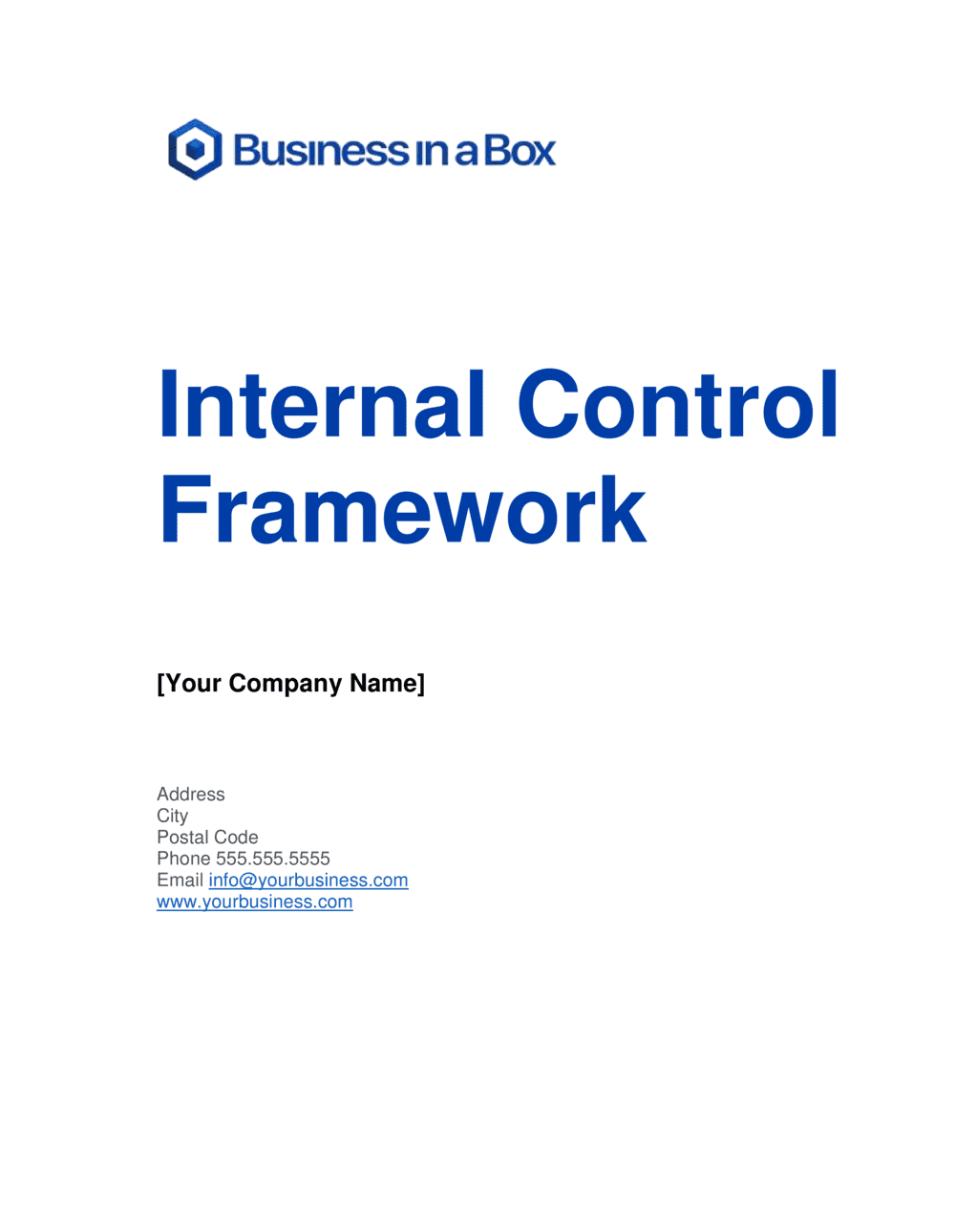Internal Control Framework Template

Document content
This internal control framework template has 10 pages and is a MS Word file type listed under our legal agreements documents.
Sample of our internal control framework template:
Internal Control Framework [Your Company Name] Address City Postal Code Phone 555.555.5555 Email info@yourbusiness.com www.yourbusiness.com Table of Contents 1. Introduction 3 1.1 Purpose 3 1.2 Scope 3 2. Control Environment 4 2.1 Leadership Commitment 4 2.2 Organization Ethics 4 2.3 Responsibility Structures 4 2.4 Competence Requirements 4 3. Risk Assessment 5 3.1 Risk Identification 5 3.2 Risk Analysis 5 3.3 Risk Response 5 3.4 Risk Appetite and Tolerance 5 4. Control Activities 6 4.1 Preventative and Detective Controls 6 4.2 Physical and Logical Access Controls 6 4.3 Authorization and Approval Protocols 6 4.4 Documentation Standards 6 5. Information and Communication 7 5.1 Information Quality 7 5.2 Operational and Financial Reporting 7 5.3 Communication Channels 7 5.4 External Communication 7 6. Monitoring Activities 8 6.1 Continual Monitoring Programs 8 6.2 Independent Audits 8 6.3 Management and Board Reviews 8 7. Review and Improvement 9 7.1 Feedback Mechanisms 9 7.2 Continual Improvement 9 7.3 Change Management 9 8. Conclusion 10 8.1 Reaffirmation of Commitment 10 8.2 Accountability and Transparency 10 1. Introduction 1.1 Purpose Detail the overarching goals of establishing robust internal controls, focusing on safeguarding assets, ensuring accuracy and reliability of financial and operational information, and promoting operational efficiency. 1.2 Scope Clearly define the boundaries and coverage of the internal control system, encompassing all subsidiaries, divisions, and departments within the organization. 2. Control Environment 2.1 Leadership Commitment Describe how top management demonstrates its commitment to integrity and ethical values, setting the tone from the top. 2.2 Organization Ethics Outline the ethical standards, including conflict of interest policies and codes of conduct, that guide employee behavior and decisions. 2.3 Responsibility Structures Detail the organizational hierarchy, specifying roles and responsibilities at all levels for internal controls. 2.4 Competence Requirements Define the requisite knowledge and skills for various roles, linking human resource policies with expected competence levels. 3. Risk Assessment 3.1 Risk Identification Describe systematic processes for identifying risks that might impede the organization's objectives, including financial, operational, compliance, and reputational risks. 3.2 Risk Analysis List the methods and tools used to assess the likelihood and impact of identified risks. 3
3,000+ Templates & Tools to Help You Start, Run & Grow Your Business

Document content
This internal control framework template has 10 pages and is a MS Word file type listed under our legal agreements documents.
Sample of our internal control framework template:
Internal Control Framework [Your Company Name] Address City Postal Code Phone 555.555.5555 Email info@yourbusiness.com www.yourbusiness.com Table of Contents 1. Introduction 3 1.1 Purpose 3 1.2 Scope 3 2. Control Environment 4 2.1 Leadership Commitment 4 2.2 Organization Ethics 4 2.3 Responsibility Structures 4 2.4 Competence Requirements 4 3. Risk Assessment 5 3.1 Risk Identification 5 3.2 Risk Analysis 5 3.3 Risk Response 5 3.4 Risk Appetite and Tolerance 5 4. Control Activities 6 4.1 Preventative and Detective Controls 6 4.2 Physical and Logical Access Controls 6 4.3 Authorization and Approval Protocols 6 4.4 Documentation Standards 6 5. Information and Communication 7 5.1 Information Quality 7 5.2 Operational and Financial Reporting 7 5.3 Communication Channels 7 5.4 External Communication 7 6. Monitoring Activities 8 6.1 Continual Monitoring Programs 8 6.2 Independent Audits 8 6.3 Management and Board Reviews 8 7. Review and Improvement 9 7.1 Feedback Mechanisms 9 7.2 Continual Improvement 9 7.3 Change Management 9 8. Conclusion 10 8.1 Reaffirmation of Commitment 10 8.2 Accountability and Transparency 10 1. Introduction 1.1 Purpose Detail the overarching goals of establishing robust internal controls, focusing on safeguarding assets, ensuring accuracy and reliability of financial and operational information, and promoting operational efficiency. 1.2 Scope Clearly define the boundaries and coverage of the internal control system, encompassing all subsidiaries, divisions, and departments within the organization. 2. Control Environment 2.1 Leadership Commitment Describe how top management demonstrates its commitment to integrity and ethical values, setting the tone from the top. 2.2 Organization Ethics Outline the ethical standards, including conflict of interest policies and codes of conduct, that guide employee behavior and decisions. 2.3 Responsibility Structures Detail the organizational hierarchy, specifying roles and responsibilities at all levels for internal controls. 2.4 Competence Requirements Define the requisite knowledge and skills for various roles, linking human resource policies with expected competence levels. 3. Risk Assessment 3.1 Risk Identification Describe systematic processes for identifying risks that might impede the organization's objectives, including financial, operational, compliance, and reputational risks. 3.2 Risk Analysis List the methods and tools used to assess the likelihood and impact of identified risks. 3
Easily Create Any Business Document You Need in Minutes.

Access over 3,000+ business and legal templates for any business task, project or initiative.

Customize your ready-made business document template and save it in the cloud.

Share your files and folders with your team. Create a space of seamless collaboration.
Templates and Tools to Manage Every Aspect of Your Business.
Business in a Box Covers Every Business Department
Includes 16 Types of Business Documents You Need
and Achieve Your Business Goals Faster.
